ECU GMC YUKON DENALI 2004 Owners Manual
[x] Cancel search | Manufacturer: GMC, Model Year: 2004, Model line: YUKON DENALI, Model: GMC YUKON DENALI 2004Pages: 468, PDF Size: 3.18 MB
Page 7 of 468
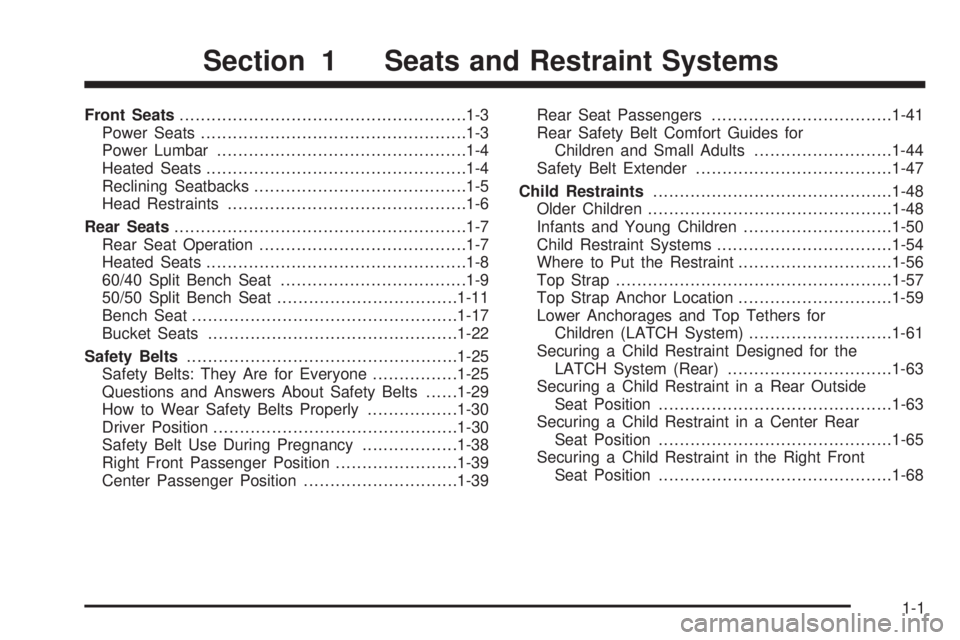
Front Seats......................................................1-3
Power Seats..................................................1-3
Power Lumbar...............................................1-4
Heated Seats.................................................1-4
Reclining Seatbacks........................................1-5
Head Restraints.............................................1-6
Rear Seats.......................................................1-7
Rear Seat Operation.......................................1-7
Heated Seats.................................................1-8
60/40 Split Bench Seat...................................1-9
50/50 Split Bench Seat..................................1-11
Bench Seat..................................................1-17
Bucket Seats...............................................1-22
Safety Belts...................................................1-25
Safety Belts: They Are for Everyone................1-25
Questions and Answers About Safety Belts......1-29
How to Wear Safety Belts Properly.................1-30
Driver Position..............................................1-30
Safety Belt Use During Pregnancy..................1-38
Right Front Passenger Position.......................1-39
Center Passenger Position.............................1-39Rear Seat Passengers..................................1-41
Rear Safety Belt Comfort Guides for
Children and Small Adults..........................1-44
Safety Belt Extender.....................................1-47
Child Restraints.............................................1-48
Older Children..............................................1-48
Infants and Young Children............................1-50
Child Restraint Systems.................................1-54
Where to Put the Restraint.............................1-56
Top Strap....................................................1-57
Top Strap Anchor Location.............................1-59
Lower Anchorages and Top Tethers for
Children (LATCH System)...........................1-61
Securing a Child Restraint Designed for the
LATCH System (Rear)...............................1-63
Securing a Child Restraint in a Rear Outside
Seat Position............................................1-63
Securing a Child Restraint in a Center Rear
Seat Position............................................1-65
Securing a Child Restraint in the Right Front
Seat Position............................................1-68
Section 1 Seats and Restraint Systems
1-1
Page 17 of 468
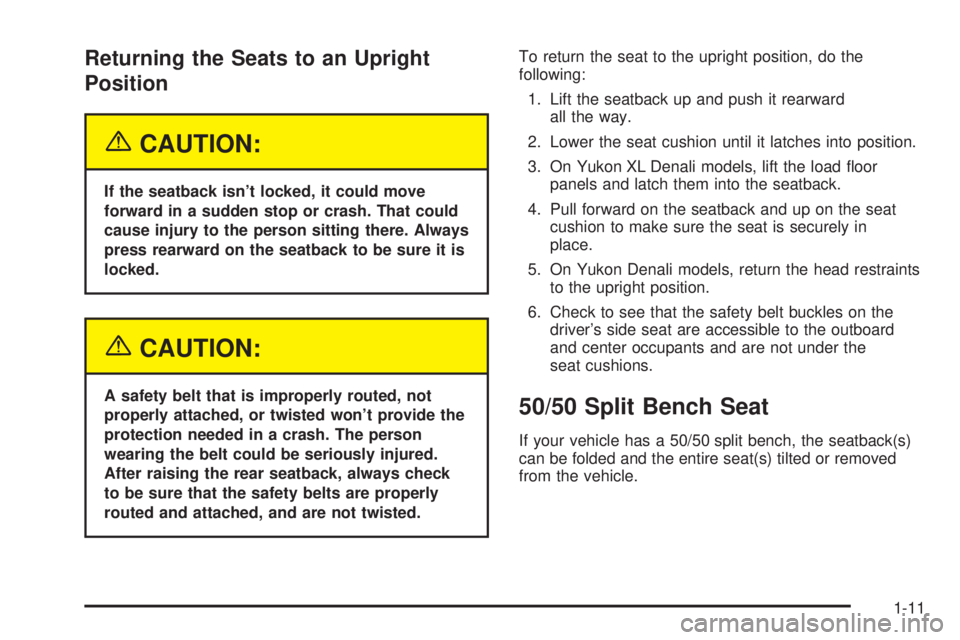
Returning the Seats to an Upright
Position
{CAUTION:
If the seatback isn't locked, it could move
forward in a sudden stop or crash. That could
cause injury to the person sitting there. Always
press rearward on the seatback to be sure it is
locked.
{CAUTION:
A safety belt that is improperly routed, not
properly attached, or twisted won't provide the
protection needed in a crash. The person
wearing the belt could be seriously injured.
After raising the rear seatback, always check
to be sure that the safety belts are properly
routed and attached, and are not twisted.To return the seat to the upright position, do the
following:
1. Lift the seatback up and push it rearward
all the way.
2. Lower the seat cushion until it latches into position.
3. On Yukon XL Denali models, lift the load ¯oor
panels and latch them into the seatback.
4. Pull forward on the seatback and up on the seat
cushion to make sure the seat is securely in
place.
5. On Yukon Denali models, return the head restraints
to the upright position.
6. Check to see that the safety belt buckles on the
driver's side seat are accessible to the outboard
and center occupants and are not under the
seat cushions.50/50 Split Bench Seat
If your vehicle has a 50/50 split bench, the seatback(s)
can be folded and the entire seat(s) tilted or removed
from the vehicle.
1-11
Page 23 of 468

2. Once the latches are
engaged, let the seat
drop into place.
Release the lever
labeled 1 and pull the
seatback up using
the assist strap on the
outboard side of the
seat to return it to
its upright position.
3. Push and pull on the seat to make sure it is locked
into place. The seatback cannot be raised to the
upright position unless the seat is secured to
the ¯oor.
Bench Seat
If your vehicle has a full bench, the seatback can be
folded and the seat can be tilted or removed from
the vehicle.
Folding the Seatback
{CAUTION:
If the seatback isn't locked, it could move
forward in a sudden stop or crash. That could
cause injury to the person sitting there. Always
press rearward on the seatback to be sure it is
locked.
To fold the seatback on the bench seat, do the following:
Pull up on the release
lever labeled 1 located on
the rear of the seatback
and push the seatback
forward.
1-17
Page 27 of 468
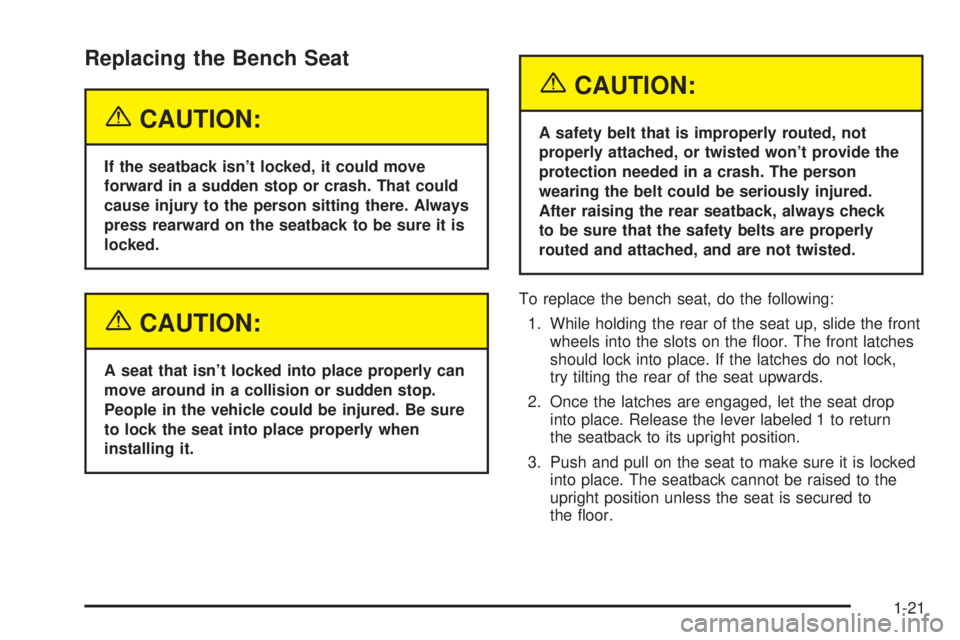
Replacing the Bench Seat
{CAUTION:
If the seatback isn't locked, it could move
forward in a sudden stop or crash. That could
cause injury to the person sitting there. Always
press rearward on the seatback to be sure it is
locked.
{CAUTION:
A seat that isn't locked into place properly can
move around in a collision or sudden stop.
People in the vehicle could be injured. Be sure
to lock the seat into place properly when
installing it.
{CAUTION:
A safety belt that is improperly routed, not
properly attached, or twisted won't provide the
protection needed in a crash. The person
wearing the belt could be seriously injured.
After raising the rear seatback, always check
to be sure that the safety belts are properly
routed and attached, and are not twisted.
To replace the bench seat, do the following:
1. While holding the rear of the seat up, slide the front
wheels into the slots on the ¯oor. The front latches
should lock into place. If the latches do not lock,
try tilting the rear of the seat upwards.
2. Once the latches are engaged, let the seat drop
into place. Release the lever labeled 1 to return
the seatback to its upright position.
3. Push and pull on the seat to make sure it is locked
into place. The seatback cannot be raised to the
upright position unless the seat is secured to
the ¯oor.
1-21
Page 30 of 468
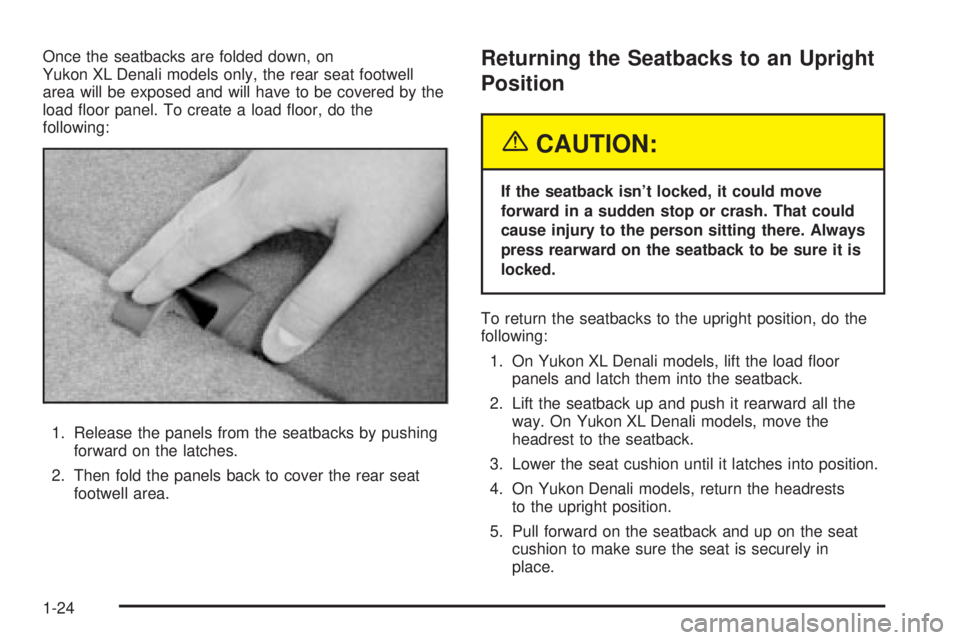
Once the seatbacks are folded down, on
Yukon XL Denali models only, the rear seat footwell
area will be exposed and will have to be covered by the
load ¯oor panel. To create a load ¯oor, do the
following:
1. Release the panels from the seatbacks by pushing
forward on the latches.
2. Then fold the panels back to cover the rear seat
footwell area.Returning the Seatbacks to an Upright
Position
{CAUTION:
If the seatback isn't locked, it could move
forward in a sudden stop or crash. That could
cause injury to the person sitting there. Always
press rearward on the seatback to be sure it is
locked.
To return the seatbacks to the upright position, do the
following:
1. On Yukon XL Denali models, lift the load ¯oor
panels and latch them into the seatback.
2. Lift the seatback up and push it rearward all the
way. On Yukon XL Denali models, move the
headrest to the seatback.
3. Lower the seat cushion until it latches into position.
4. On Yukon Denali models, return the headrests
to the upright position.
5. Pull forward on the seatback and up on the seat
cushion to make sure the seat is securely in
place.
1-24
Page 37 of 468
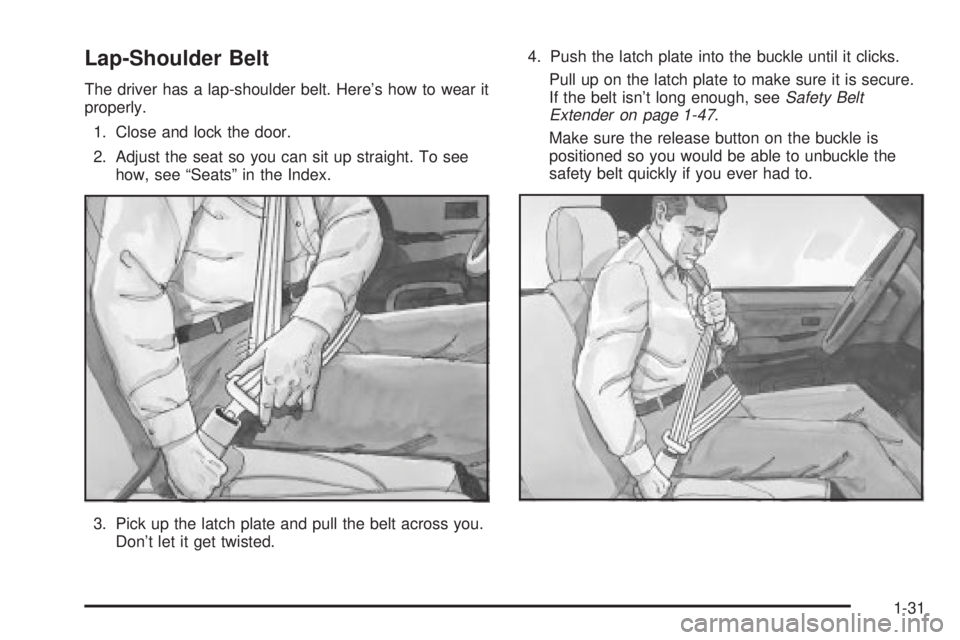
Lap-Shoulder Belt
The driver has a lap-shoulder belt. Here's how to wear it
properly.
1. Close and lock the door.
2. Adjust the seat so you can sit up straight. To see
how, see ªSeatsº in the Index.
3. Pick up the latch plate and pull the belt across you.
Don't let it get twisted.4. Push the latch plate into the buckle until it clicks.
Pull up on the latch plate to make sure it is secure.
If the belt isn't long enough, seeSafety Belt
Extender on page 1-47.
Make sure the release button on the buckle is
positioned so you would be able to unbuckle the
safety belt quickly if you ever had to.
1-31
Page 48 of 468
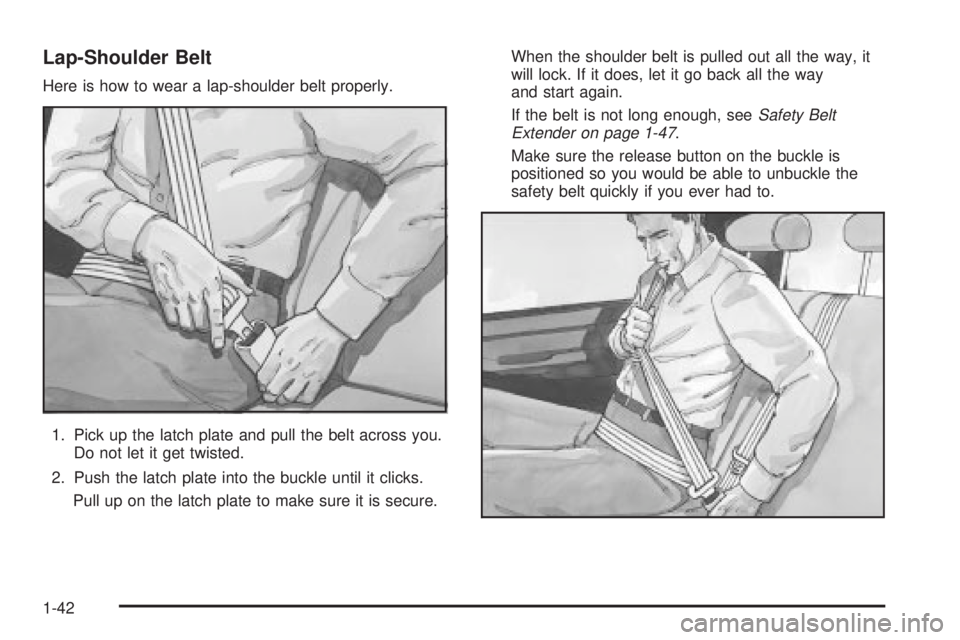
Lap-Shoulder Belt
Here is how to wear a lap-shoulder belt properly.
1. Pick up the latch plate and pull the belt across you.
Do not let it get twisted.
2. Push the latch plate into the buckle until it clicks.
Pull up on the latch plate to make sure it is secure.When the shoulder belt is pulled out all the way, it
will lock. If it does, let it go back all the way
and start again.
If the belt is not long enough, see
Safety Belt
Extender on page 1-47.
Make sure the release button on the buckle is
positioned so you would be able to unbuckle the
safety belt quickly if you ever had to.
1-42
Page 57 of 468
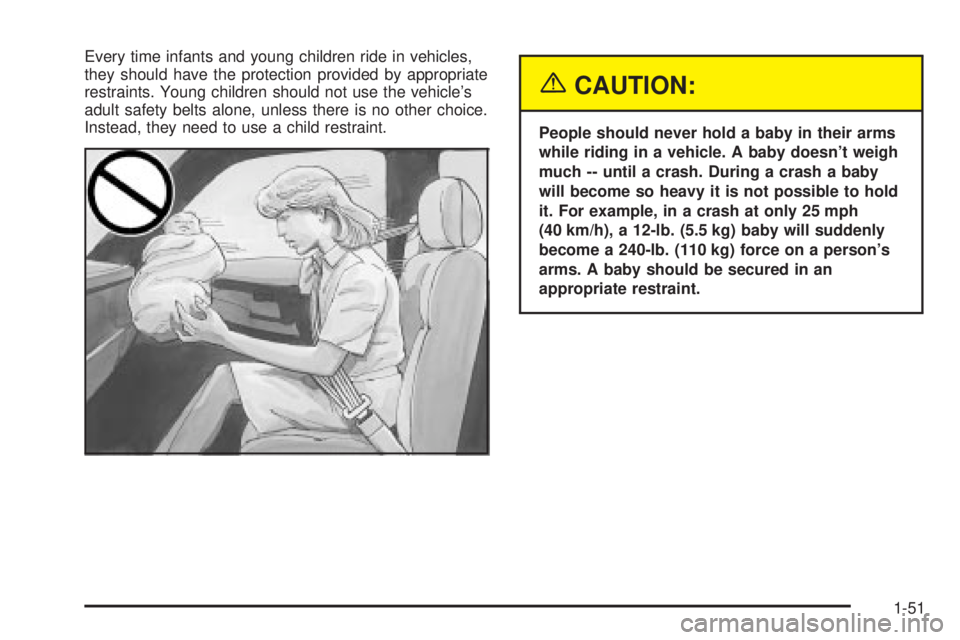
Every time infants and young children ride in vehicles,
they should have the protection provided by appropriate
restraints. Young children should not use the vehicle's
adult safety belts alone, unless there is no other choice.
Instead, they need to use a child restraint.
{CAUTION:
People should never hold a baby in their arms
while riding in a vehicle. A baby doesn't weigh
much -- until a crash. During a crash a baby
will become so heavy it is not possible to hold
it. For example, in a crash at only 25 mph
(40 km/h), a 12-lb. (5.5 kg) baby will suddenly
become a 240-lb. (110 kg) force on a person's
arms. A baby should be secured in an
appropriate restraint.
1-51
Page 59 of 468
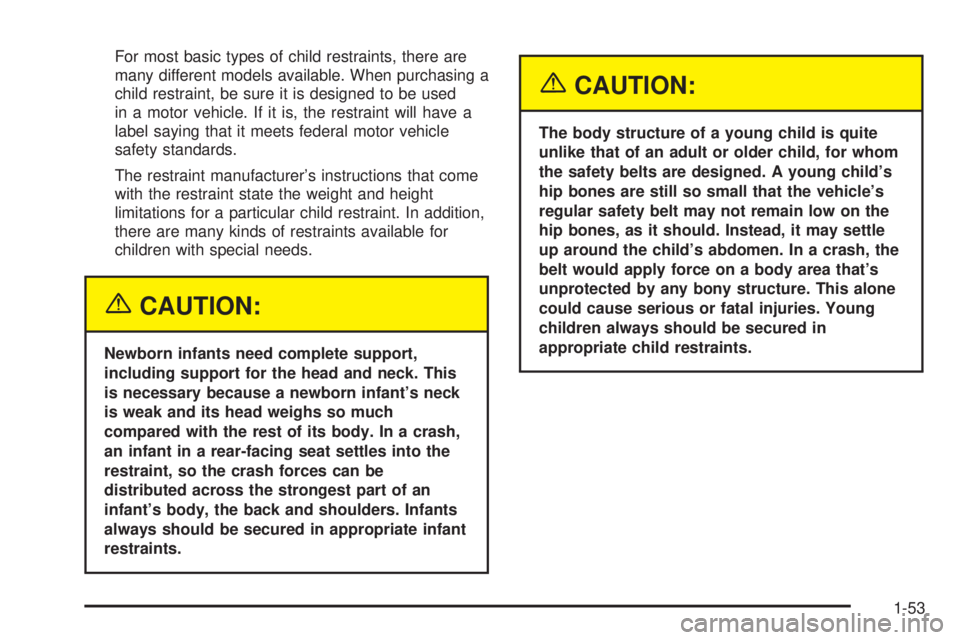
For most basic types of child restraints, there are
many different models available. When purchasing a
child restraint, be sure it is designed to be used
in a motor vehicle. If it is, the restraint will have a
label saying that it meets federal motor vehicle
safety standards.
The restraint manufacturer's instructions that come
with the restraint state the weight and height
limitations for a particular child restraint. In addition,
there are many kinds of restraints available for
children with special needs.
{CAUTION:
Newborn infants need complete support,
including support for the head and neck. This
is necessary because a newborn infant's neck
is weak and its head weighs so much
compared with the rest of its body. In a crash,
an infant in a rear-facing seat settles into the
restraint, so the crash forces can be
distributed across the strongest part of an
infant's body, the back and shoulders. Infants
always should be secured in appropriate infant
restraints.
{CAUTION:
The body structure of a young child is quite
unlike that of an adult or older child, for whom
the safety belts are designed. A young child's
hip bones are still so small that the vehicle's
regular safety belt may not remain low on the
hip bones, as it should. Instead, it may settle
up around the child's abdomen. In a crash, the
belt would apply force on a body area that's
unprotected by any bony structure. This alone
could cause serious or fatal injuries. Young
children always should be secured in
appropriate child restraints.
1-53
Page 62 of 468

Q:How do child restraints work?
A:A child restraint system is any device designed for
use in a motor vehicle to restrain, seat, or position
children. A built-in child restraint system is a
permanent part of the motor vehicle. An add-on
child restraint system is a portable one, which
is purchased by the vehicle's owner.
For many years, add-on child restraints have used
the adult belt system in the vehicle. To help
reduce the chance of injury, the child also has to be
secured within the restraint. The vehicle's belt
system secures the add-on child restraint in the
vehicle, and the add-on child restraint's harness
system holds the child in place within the restraint.
One system, the three-point harness, has straps that
come down over each of the infant's shoulders and
buckle together at the crotch. The ®ve-point harness
system has two shoulder straps, two hip straps and a
crotch strap. A shield may take the place of hip
straps. A T-shaped shield has shoulder straps that
are attached to a ¯at pad which rests low against the
child's body. A shelf- or armrest-type shield has
straps that are attached to a wide, shelf-like shield
that swings up or to the side.When choosing a child restraint, be sure the child
restraint is designed to be used in a vehicle. If it is, it
will have a label saying that it meets federal motor
vehicle safety standards.
Then follow the instructions for the restraint. You may
®nd these instructions on the restraint itself or in a
booklet, or both. These restraints use the belt system or
the LATCH system in your vehicle, but the child also
has to be secured within the restraint to help reduce the
chance of personal injury. When securing an add-on
child restraint, refer to the instructions that come with the
restraint which may be on the restraint itself or in a
booklet, or both, and to this manual. The child restraint
instructions are important, so if they are not available,
obtain a replacement copy from the manufacturer.
Where to Put the Restraint
Accident statistics show that children are safer if they
are restrained in the rear rather than the front seat.
General Motors recommends that child restraints
be secured in a rear seat, including an infant riding in a
rear-facing infant seat, a child riding in a forward-facing
child seat and an older child riding in a booster seat.
Your vehicle has a rear seat that will accommodate
a rear-facing child restraint. A label on your sun visor
says,²Never put a rear-facing child seat in the
front.²This is because the risk to the rear-facing child is
so great, if the air bag deploys.
1-56